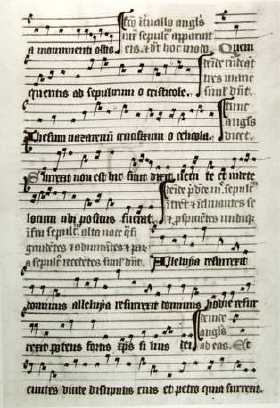The drama reborn
Appropriately enough, it was the dramatic nature of Christian rituals which resulted in the rebirth of the drama after the Church had suppressed it. This document, preserved from the tenth century, shows just how it happened: the Quem quaeritis trope* .
It is a very brief dramatization of that high point in the Christian year which occurs as the congregation (or audience) is reminded of the first moment when the resurrection was revealed: when the Marys arrive at the tomb in which Jesus was buried, discover that the stone has been rolled away, and that the body of Jesus is no longer inside. The angels guarding the tomb then announce the resurrection. (Click here for a note on the music*.)
The text translated
Here is a translation of this early playlet (or mini-opera, since it was originally sung:
Question [by the Angels]: whom seek ye in the sepulchre, O followers of Christ?
Answer [by the Marys]: Jesus of Nazareth, who was crucified, O heavenly ones.
The Angels: He is not here; he is risen, just as he foretold. Go, announce that he is risen from the sepulchre.
Footnotes
-
Trope
In this usage, a "trope" is text added to the words of the mass; Quem quaeritis translates "Whom seek ye."
-
The music
The written music in the illustration is a plainsong chant; the actual melody is not recorded in this program, but you can click here to listen to part of the chant "Veni Creator Spiritus" (Come Holy Ghost).
